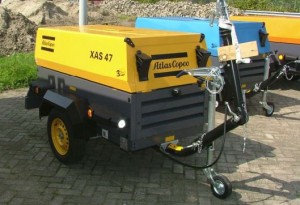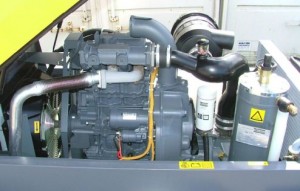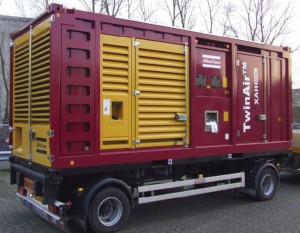Portable air compressors are the work-horse of building and construction sites. They supply compressed air, and lots of it, to power all kinds of heavy tools.
They also go by the name of tow-behind compressor, mobile compressor, diesel-driven compressor or simply diesel compressor. These diesel-powered beasts supply the compressed air needed to do the toughest jobs!
Portable air compressors come in all kinds and sizes. But when I talk about a portable air compressor, I'm talking about the big one, as used on construction sites.
There are many other types of portable air compressors, but those are covered under 12 volt-, home-, or small air compressors.
Portable compressors are driven by a big diesel engine. The size of the engine and the compressor depends on the air flow that is required and the air pressure.
Portable air compressors can usually deliver from 7 to 12 bars.
The amount of air they can product per minute (the air flow) vary between types.
What size of compressor you need depends on the air-tools you use.
Do they require a lot of air, do they require high pressure?
Most air tools in construction and general use require around 7 bar, but the air flow varies greatly.
Who uses portable compressors?
A portable air compressor is used to supply compressed air on construction sites, road works, or whenever people need compressed air where a stationary compressor is not suitable.
They are also used as (emergency) backup compressors for factories, for example when their stationary compressor needs maintenance or stopped working. They are powered by diesel engines, so they don't need electricity.
Strong and reliable
 Small portable air compressor
Small portable air compressor
A portable air compressor needs to be robust, strong and reliable. They are often used in dusty environments, so good high-quality air filters is a must.
They need to work in all kinds of conditions like very cold weather or high altitude (for example, compressed air is used to make snow for skiing), but they also have to function in very dusty and hot environment or very wet conditions.
Above is true for both the compressor part and the diesel engine. The diesel engine has to be strong and reliable.
The worst thing that can happen is that your compressor breaks down in the middle of nowhere and you're stuck without compressed air.
The compressor
In almost all cases, the compressor is of the rotary screw type. It can be oil-injected or oil-free, although the oil-free ones are very expensive and only used for special applications (for example, the big Atlas Copco oil-free portable compressors can only be rented, not bought (in Europe at least).
So, 99% of the portable compressors are oil-injected, single-stage rotary screw compressors. They work almost in the same way as a stationary electrical rotary screw compressor works. There are some minor differences though, especially in the control system.
The diesel engine
Diesel engines are used to drive portable air compressors. They are strong, reliable and can run for hours or weeks at a time.
The engine is either directly coupled to the compressor element or is connected with pulleys and a belt. Just like in your car, the engine used a starter motor to start-up, so the portable compressor also has a battery.
 Inside a portable air compressor. With the diesel engine on the left and the compressor on the right
Inside a portable air compressor. With the diesel engine on the left and the compressor on the right
Operation and control system
The engine has (as a minimum) safety devises for low oil pressure and/or oil level and too high temperature. The speed of the engine is controlled by the compressors control system.
Most of the time this is a fairly simple control system (all pneumatic, minimum amount of electronics). Especially compared to stationary compressors, which nowadays feature control panels with sophisticated microcontrollers and lots of settings and options.
Not the portable compressor... It has basically a start/stop button, sometimes a load/unload button, no indicator lights and an hour-counter.
Options
Portable air compressors are available with many different options and extra's. Basic options for portable air compressors include:
- After cooler (to cool down the compressed air)
- Moisture traps, filters for dust, oil, water or fumes (depending on needed compressed air quality)
- Re-heater (to heat-up the cooled-down air, to prevent moisture problems)
- Different tow-bar designs (depending on your car / truck)
- Heavy duty compressor inlet filter (for very dusty environments).
- Cold start (for operation in cold area's)
- Spark-arrestor (see below)
- Intake shutoff valve (see below)
If the portable air compressor is used in explosive or flammable environments, a spark-arrestor is fitted to the exhaust pipe, to prevent any sparks from flying out and starting a fire. They can be required by law in some places on this earth (especially in forests or on chemical/oil refineries for example).
When the portable air compressor is used in environments where chemicals or flammable gasses can be present in the air (on oil- or chemical refineries for example), an air intake shut off valve is required.
Chances are that the diesel engine sucks-in flammable gasses. The gasses will ignite inside the diesel engine, making it impossible to stop. Or it could 'go nuts' and start running faster and faster.. For this reason, a shut off valve is fitted in the air supply (just behind the air filter). It will shut down the air supply in case of such an event.
 Very big portable air compressor ('twin air' because it has two compressor elements!)
Very big portable air compressor ('twin air' because it has two compressor elements!)
Portable air compressor parts and maintenance
Because you use your portable compressor in remote area's, you need top be able to rely on your portable compressor.
Good maintenance is very important to keep your compressor running nice and smooth.
Maybe it's a good idea to keep a few essential spare parts in stock, so you can be up and running in no time when your compressor breaks down unexpectedly.
Reed more about this on our portable air compressor parts and maintenance page.
Operating instructions
You read the manual, right? If not, you should do it now!
I have been asked so many questions about portable air compressors, and I have seen so many 'break downs' that where due to misunderstandings or bad operation of the compressor...
Just imagine how much damage could be avoided (and money saved) if everybody just knew how to properly start and stop their portable air compressor.
Learn more about this on our portable air compressor operation and the control system page.
Buying a portable compressor
Looking for the best portable compressor for you? Portable air compressors come in many different styles and sizes so it's important to be informed and make the right decision.
Plus, there are many extra's and options which can make a big difference in daily use, so again, it's important to be informed and make the right decision.
